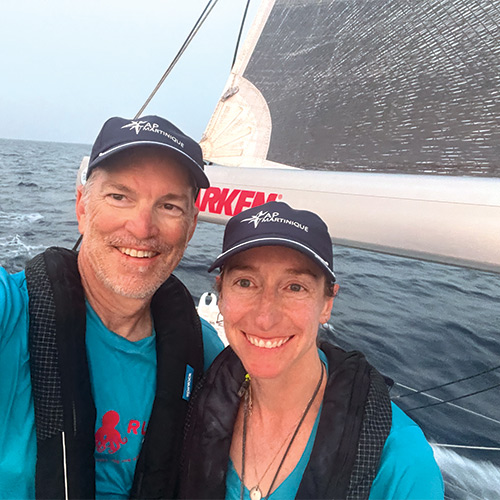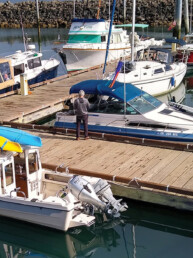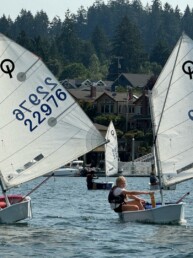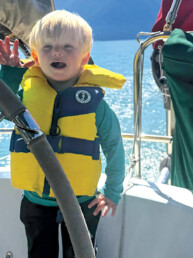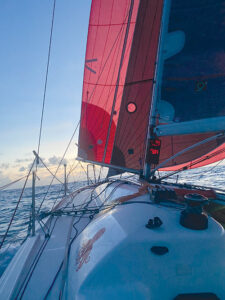
This was going to be the granddaddy of all races for us on Red Ruby. After two years of overnight races in Europe, including Fastnet and the Middle Sea Race, Cap-Martinique would be the next level—4,000 miles from La Trinité, France to Martinique in the Eastern Caribbean, leaving the island of Madeira to starboard. Besides races that are non-stop around the world, at over 4,000 miles, the Cap-Martinique is one of the longest ocean races in the world.
The appealing part of this race wasn’t necessarily the distance, or the challenge, it was the fact that there would be 60 shorthanded crews competing (40 doublehanded and 20 singlehanded). All of the boats were between 30 and 36 feet (Red Ruby is a 33-foot SunFast 3300) and all are a similar speed. Think about it this way: If this fleet registered for Round the County, they would all race in the same division! We were one of only three non-French teams and we knew it was going to be competitive, an adventure, and long.
We started planning for Cap-Martinique a-year-and-half before the start, but we only arrived to La Trinité a week before. We’d done everything in advance that we could think of. What could go wrong? How could we prevent it from happening or mitigate it if it did? We brought two laptops, two satellite phones, two Jet Boil stoves, and five spinnakers. It turns out that only one week of pre-race time with Red Ruby required some very long days to get ready, but we passed our safety inspection and medical kit inspection with flying colors. As a bonus, we were able to have savory crepes (a Brittany specialty) every day for lunch.
Race day arrived and a crowd of hundreds lined the pier. Each boat was released from the dock after a hug from the race organizer, in very precise 5 minute intervals, while bagpipes played and an announcer introduced each team. We had a really nice start, led the fleet for the first few minutes and exited the Bay of Quiberon in the top 10. Sailing onto a nice jib reach that alternated to a Code Zero reach and back to the jib, we went 350 miles across the notorious Bay of Biscay to Cape Finisterre. When we reached Cape Finisterre a day and a half later, we were leading the fleet of 60 boats. Could we win this thing?

The forecast south of Cape Finisterre was for 50 knot gusts from behind. It was early, and we really didn’t want to break anything, so we opted to head farther west to avoid the strongest winds. That meant passing west of a large Traffic Separation Scheme that we were required to avoid and created a significant split from the majority of the fleet. Then things went sideways for lots of folks. The previous winner of the race broke his mast while leading. A singlehander went overboard, while tethered, and was able to get back onboard. The wise boats took down their spinnakers and poled out their jibs. We were not among the wise.
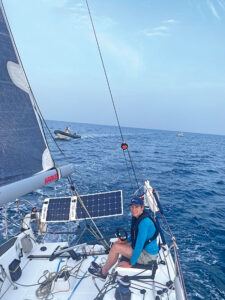
Instead, we went super fast in 30 knots with our A4 kite up, right up until we didn’t. Then we laid on our side for 5 minutes, washed the jib overboard, still attached by the tack and halyard (can you say bucket?), and wrapped the kite around everything including the topping lift for the pole. It took us well over an hour to get the kite down, with the jib dragging in the water the entire time. By the time we’d gotten everything sorted we’d both been up and working hard for 3 hours, it was about midnight, and we were wiped out. All we could muster was dead downwind with the main until daybreak. It was hard. Then it got harder.
The race organizers sent everyone an email letting us know that one of the solo competitors had fallen overboard near Cape Finisterre. His body was recovered by Spanish rescue authorities. We were crushed. Philippe Benoiton had been the one competitor that reached out to us months before, offering a place to stay in La Trinité. He also helped us move our boat and translated for us during the race dinner. He had told us in an email that he wasn’t a racer, he was just here for the adventure. His loss cast a somber tone for our race, and he was in our thoughts every day.
The winds got progressively lighter over the next few days, all the way down to zero. We started to feel a bit better and we were reconvening with the fleet, still well in contention. Our only mishap was blowing a trusty A2 spinnaker completely in half in 20 knots, from a rough leftover swell from the 40-50 knots to the north of us. No biggie, we thought, as we had another A2. Or was it?
Reaching Madeira was special. The winds were pleasant, it was much warmer (April in the Bay Biscay can be very similar to sailing in the Pacific Northwest in April) and we could see three of our competitors as the fleet converged for the rounding. We also got to see land after 7 days, and then it was time for the long crossing of the Atlantic to Martinique. We still had 2,800 miles to go!
As we left Madeira, we were within 16 miles of the lead boat (a slower solo boat that was absolutely crushing it!) and we were ready to settle into a long downwind leg with our big asymmetrical spinnaker flown from a spinnaker pole. This was our secret weapon. We were slightly lighter than our competition and flying a kite roughly 10% bigger. Zoom, zoom!
Well, sometimes the best planning and best intentions don’t turn out quite like you expect. For a variety of reasons, some that still remain unclear, we alternated between being slightly slower and the same speed as the leaders. We tried everything we could think of, and we ended up really missing that A2 we blew in half, but we never cracked the code on our boat speed.
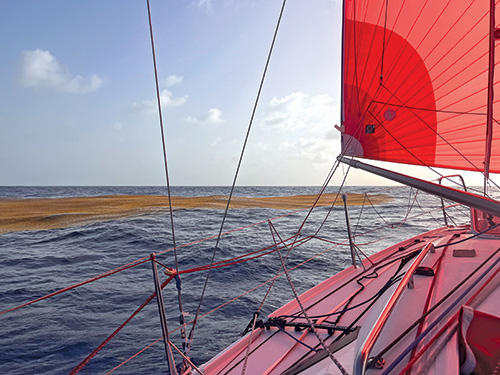
One other surprise was the Sargasso Sea. I thought the Sargasso Sea was just to the west of the Caribbean. In fact, we started seeing a lot of sargasso weed before Madeira on the other side of the Atlantic, and it collected perfectly on the keel and both rudders, like tumbleweed collects other tumbleweed. Fortunately, we had installed a keel camera over the winter, and we had a special carbon weed stick for the rudders and a homemade rope-a-dope complete with a Kong dog toy and pieces of sponge to floss the keel. Malcolm Gladwell says if you do something 10,000 times you become an expert. I can confirm that is true when it comes to keel flossing. Wow. How on earth did the solo folks do it?
Twenty-two days after leaving France, we arrived in Martinique to a marvelous welcoming committee. We were the 10th boat across the line and the 7th doublhanded boat. The crazy thing about this closely contested, long race, is that we ended up 10th on corrected time, 6 minutes out of 9th, and just 67 minutes out of 6th. The race took us 520 hours, which equates to a 0.2% difference between 6th and 10th, and so the race lived up to the expectation of being extremely close.
Yes, we were a bit disappointed with the result, but that is the beauty of competition. We can turn that disappointment into a learning opportunity and apply what we’ve learned to the next big adventure. Red Ruby joined 40 of the race boats on a Sevenstar ship back to France in early June, just in time for the summer race season in the English Channel for Jonathan and Alyosha.
In the end, Cap Martinique was a grand adventure for us, indeed, and our longest race to date. Red Ruby brought us safely across 4,000 tough ocean miles, and is still providing rewarding and challenging puzzles along with plenty of sailing enjoyment. This race is one we’ll always remember, and holding dear the memory of Philippe’s spirit and generosity will be a big part of that.
